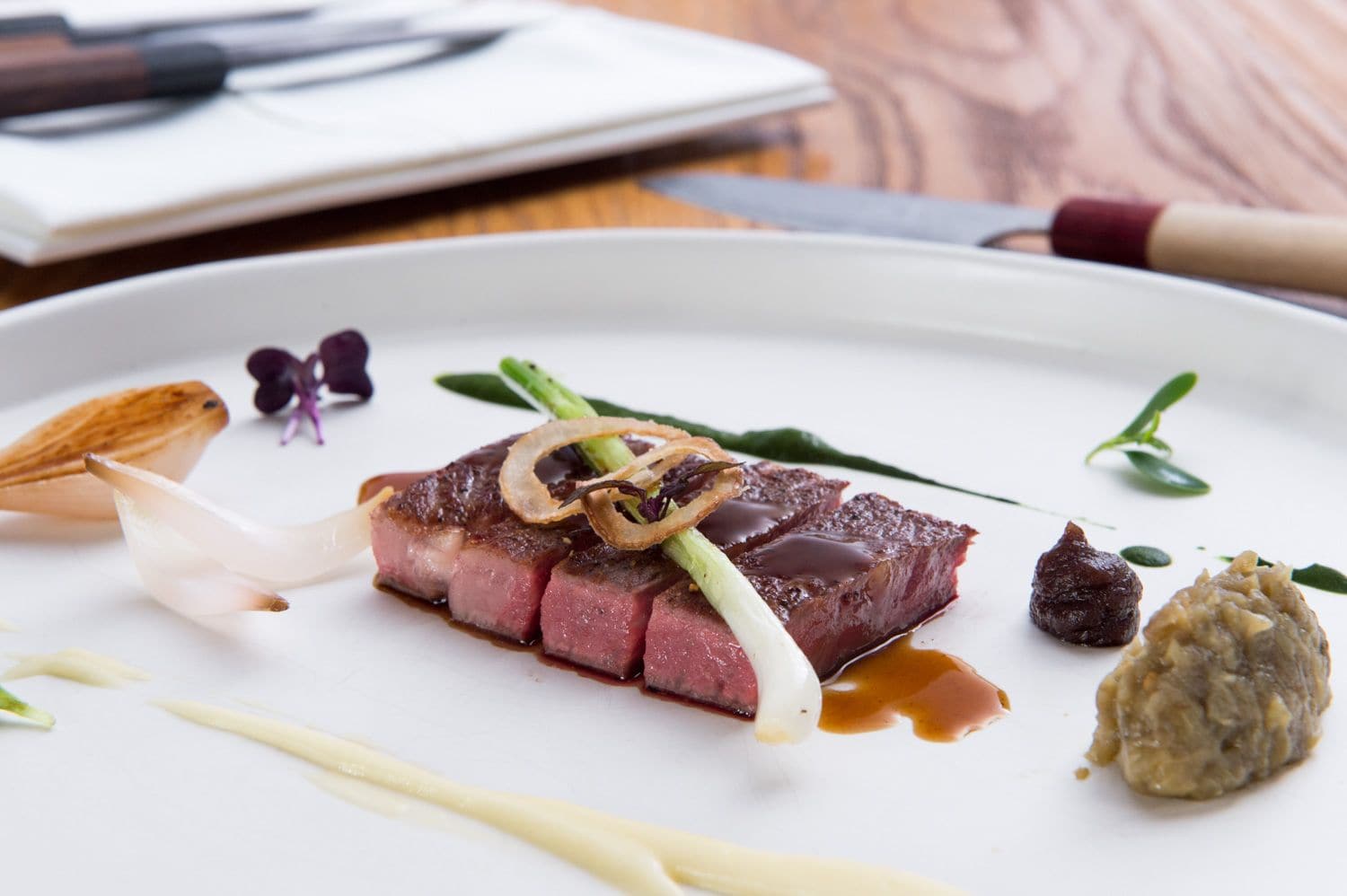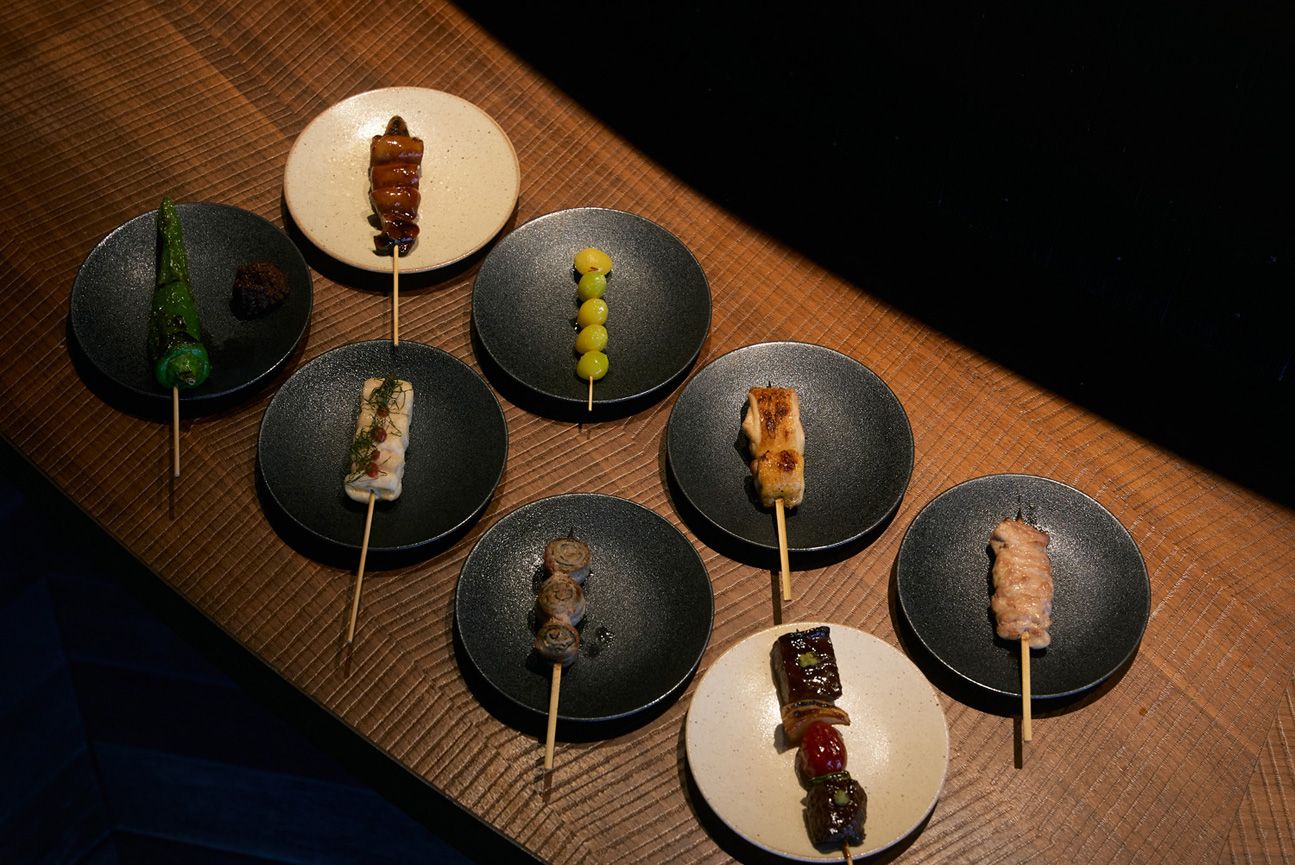
The cuisines of Japan and Peru meet at a vibrant ‘Nikkei’ restaurant in London’s East End
The signature dish at the East London restaurant Bamboo Mat is ceviche, an iconic Peruvian dish of raw fish marinated in citrus juice. But this particular ceviche also includes culinary influences from the far side of the globe to Peru, namely Japan. That’s because Bamboo Mat serves the vibrant, innovative, and on-trend Peruvian Japanese fusion cuisine known as Nikkei.
The raw fish in ceviche is typically combined with salt and citrus such as lemon or lime. But with a nod to the Japanese influence in Nikkei cuisine, Bamboo Mat marinates seabass, scallop, and prawn with yuzu. Sweet passionfruit and mango balance out the sourness of the citrus, while Peruvian cancha corn adds a pleasant crunchiness. It’s an imaginative creation that sums up the restaurant’s culinary approach on a single plate.
“You are not going to find something that is only sweet or only sour in our restaurant,” says co-owner Denis Gobjila. He describes the Nikkei cuisine as a “mix of everything,” not just a fusion of Japanese and Peruvian influences, but also a vibrant melange of tastes and textures.
Or take Bamboo Mat’s salmon teriyaki. It doesn’t look dissimilar to the dish popular both in the UK and Japan. But this version also contains a little yuzu juice, to add that special Nikkei “kick,” says Gobjila.
“Most restaurants use an ordinary teriyaki sauce, but for me that is too monotone, too sweet,” he says. Nikkei cuisine is all about kicks…. chili, lime, red onion.”

Bamboo Mat’s version of the iconic Peruvian dish ceviche contains yuzu juice from Japan.

Bamboo Mat’s salmon teriyaki also contains a “secret ingredient” of yuzu juice.
Nikkei is not the only Japanese fusion cuisine fashionable in the UK capital today. Other restaurants bring together Japanese food and Italian, French, Korean, Filipino, Mexican, or Brazilian cuisine. But compared to some newly cooked-up fusion foods, Nikkei is authentic and well established, tracing its roots back to the early-twentieth-century Japanese immigrants to Peru. Many were farmers who combined familiar cooking techniques and basic ingredients from Japan, such as miso and soy sauce, with local ingredients such as chili peppers, potatoes, citrus, and raw fish.
Officially recognized in Peru in 1980, Nikkei cuisine is a key element of the nation’s food culture. And in recent years, with the help of famous chefs, such as Ferrán and Albert Adrià, and Nobu Matsuhisa, it has become known around the world. The vibrant food culture of Peru itself has also earned an impressive reputation; the nation has been voted the “World’s Leading Culinary Destination” three years running to 2023.
A rave review and a second restaurant
In London, probably the best-known of several Nikkei restaurants is Chotto Matte in the fashionable dining and nightlife district of Soho. It was while working there that Bamboo Mat co-owners Gobjila and Victor Rosa, both originally from Moldova in Eastern Europe, met.
In May 2022, the two friends opened their own Nikkei restaurant, Bamboo Mat Leyton. A rave review from influential London food critic Grace Dent just a month later led to a slew of bookings. Gobjila and Rosa then quickly decided to open a second restaurant in nearby Stratford that December.

Bamboo Mat Stratford. Sister restaurant Bamboo Mat Leyton is located in a nearby area of East London.
Bamboo Mat Stratford seats a maximum 60 diners, twice the size of the Leyton restaurant. Its interior was created by Peruvian designer Sabastian Salas and features a ceiling hung with a striking pattern of neon ropes. (An interesting fact is that their total length equals the distance between the two sister restaurants.)
The Stratford area of East London was once one of the most deprived communities in London but was regenerated around the time of the 2012 London Olympics, and has since become home to many students and young professionals. Gobjila and Rosa live close by and noticed that the area lacked good quality Japanese restaurants. It also offers cheaper commercial rents than better known areas in the center of the city.
“Our goal was to bring Central London to East London,” says Gobjila. “We are trying to deliver quality food for reasonable prices.”
An early challenge, however, was where to source Japanese ingredients. Initially, suppliers were reluctant to deliver to East London, so Gobjila and Rosa regularly drove almost two hours one-way to the outskirts of London to buy fresh fish and other items. Today, ingredients are delivered from a Japanese food distributor in South London.
No question of compromise
But despite such difficulties, from day one there was no question of compromise.
“When you are using the original ingredients from Japan you know they are the proper ingredients,” stresses Gobjila. Other restaurants may try to cut costs by using soy sauce or vinegar from other Asian countries, he says, “[but] people who understand will notice the difference straight away.”
“We are using Japanese ingredients because we are a Japanese restaurant and we want to have high standards,” Rosa adds.
For example, their unagi and teriyaki sauces use Japanese soy sauce, vinegar, and mirin to ensure quality and authentic flavor.

Unagi-maki (sushi roll containing eel)
Bamboo Mat’s quest for authenticity even extends to the Japanese knives used in the restaurant, which are all from their previous chef roles or have been brought from Japan by themselves or friends. For making the classic Nikkei sashimi-inspired dish of tiradito, Rosa uses a long thin yanagiba knife to slice the fish sashimi style.
“It tastes completely different depending on how you cut it, which direction you cut it,” he says. And of course, the knife must be absolutely sharp.
Rosa describes Bamboo Mat’s tiradito as “very fresh, a good marriage of cultures.” It is made with Japanese fish hamachi (yellowtail), yuzu truffle soy, chives, and aji amarillo, a yellow chili pepper that is a key ingredient in Peruvian cuisine.

A Nikkei version of Peruvian tiradito. The Japanese hamachi (yellowtail) is sliced using a Japanese yanagiba knife.
From Moldova to the UK
Gobjila’s first experience of Japanese cooking was neither in Japan, the UK, or his birthplace of Moldova, where there were no Japanese restaurants, but in neighboring Ukraine. In London, he joined Nikkei restaurant Chotto Matte. There he was taught by a well-known Japanese sushi chef; or rather, in traditional fashion, he was expected to learn by close observation rather than explicit instruction.
“He was very skillful,” Gobjila recalls. “He didn’t show us a lot, but as they say in Japan you need to ‘steal’ the knowledge, not learn.”
Following this, Gobjila decided to take a break from the restaurant business. But when an opportunity to open a restaurant in Leyton came up, he and good friend Rosa decided they were ready for a challenge. It was time to dive back into the Nikkei cuisine they loved.
“We put our savings and our knowledge together and opened a restaurant,” he recalls.
Gobjila’s remains fascinated by Japanese food and recently traveled to Japan, where he visited 10 or 12 restaurants and street food stalls a day.
“I was surprised at the quality of the fish, of course; how cheap it was for the quality,” he says. “I really liked the fish markets. I went to five or six and even visited a tuna auction.”
A restaurant glossary of Spanish, English, and Japanese terms
London has a highly diverse population and eating out culture, making it the clear food capital of the UK. Around 40% of Londoners were born overseas, something reflected in the capital’s myriad of dining options. According to Gobjila, their customers are eager to try different countries’ foods, and maybe one in five or so have already tried Nikkei cuisine.
For those that are less familiar with the Nikkei cuisine, they explain some of its unusual history. They also explain the origins and ingredients of their signature ceviche and tiradito dishes. Gobjila and Rosa have prepared a glossary of mainly Japanese and Spanish terms to help kitchen and waiting staff. It covers everything from leche de tigre (a citrus-based ceviche marinade) to tataki (Japanese-style seared fish or meat.)

Bamboo Mat owners Denis Gobjila (left) and Victor Rosa are friends as well as business partners
For Gobjila and Rosa, their mission to combine the food traditions of Japan and Peru is an ongoing challenge, but an exciting one.
“If you mix Japan with Peru you have a mix of sourness, and spiciness, and fresh ingredients,” he says. “To make a good balance is really hard.”
The two cuisines originate from opposite sides of the globe, but they still meet at several key points. One is fish: like Japan, Peru is rich in seafood. Another is the emphasis that both place on fresh ingredients.
“We try to do simple things and focus on the quality of the ingredients,” says Gobjila, adding that exotic ingredients tend to add cost for the customer anyway.
“We are trying to make it simple as possible, and as fresh as possible,” he says.
Yet, even as they respect the traditions of both Peruvian and Japanese food, they continue to innovate. One example is a non-alcoholic version of the classic Peruvian anticucho sauce, which conventionally contains beer. Another is their signature ceviche, which they spent a month working on before opening their first Bamboo Mat restaurant.
“This one was the hardest. Many ingredients, many ways to make it,” remembers Gobija. Yet, the final result is an undeniably special take on the classic Peruvian dish.
For Gobjila, Nikkei food is about taking the kind of Japanese recipes that appeal to UK diners and adding a Nikkei “kick.”
For example, sushi rolls are popular in London and Bamboo Mat’s menu includes several Japan-inspired deep-fried “hot maki.” One is ceviche hot maki, a sushi roll containing ceviche and deep fried with egg, breadcrumbs, and katakuriko (Japanese potato starch.)
“If there is a ceviche tournament, we are going to win!” says Gobjila.






